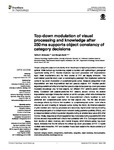Top-down modulation of visual processing and knowledge after 250 ms supports object constancy of category decisions
| dc.contributor.author | Schendan, Haline | |
| dc.contributor.author | Ganis, Giorgio | |
| dc.contributor.editor | Fields C | |
| dc.date.accessioned | 2015-08-12T15:11:40Z | |
| dc.date.accessioned | 2016-04-23T12:54:24Z | |
| dc.date.available | 2015-08-12T15:11:40Z | |
| dc.date.available | 2016-04-23T12:54:24Z | |
| dc.date.issued | 2015-09-11 | |
| dc.identifier.issn | 1664-1078 | |
| dc.identifier.issn | 1664-1078 | |
| dc.identifier.other | ARTN 1289 | |
| dc.identifier.uri | http://hdl.handle.net/10026.1/4538 | |
| dc.description.abstract |
People categorize objects slowly when visual input is highly impoverished instead of optimal. While bottom-up models may explain a decision with optimal input, perceptual hypothesis testing (PHT) theories implicate top-down processes with impoverished input. Brain mechanisms and the time course of PHT are largely unknown. This event-related potential study used a neuroimaging paradigm that implicated prefrontal cortex in top-down modulation of occipitotemporal cortex. Subjects categorized more impoverished and less impoverished real and pseudo objects. PHT theories predict larger impoverishment effects for real than pseudo objects because top-down processes modulate knowledge only for real objects, but different PHT variants predict different timing. Consistent with parietal-prefrontal PHT variants, around 250 ms, the earliest impoverished real object interaction started on an N3 complex, which reflects interactive cortical activity for object cognition. N3 impoverishment effects localized to both prefrontal and occipitotemporal cortex for real objects only. The N3 also showed knowledge effects by 230 ms that localized to occipitotemporal cortex. Later effects reflected (a) word meaning in temporal cortex during the N400, (b) internal evaluation of prior decision and memory processes and secondary higher-order memory involving anterotemporal parts of a default mode network during posterior positivity (P600), and (c) response related activity in posterior cingulate during an anterior slow wave (SW) after 700 ms. Finally, response activity in supplementary motor area during a posterior SW after 900 ms showed impoverishment effects that correlated with RTs. Convergent evidence from studies of vision, memory, and mental imagery which reflects purely top-down inputs, indicates that the N3 reflects the critical top-down processes of PHT. A hybrid multiple-state interactive, PHT and decision theory best explains the visual constancy of object cognition. | |
| dc.format.extent | 1289- | |
| dc.format.medium | Electronic-eCollection | |
| dc.language | English | |
| dc.language.iso | English | |
| dc.publisher | Frontiers | |
| dc.relation.replaces | http://hdl.handle.net/10026.1/3518 | |
| dc.relation.replaces | 10026.1/3518 | |
| dc.subject | Category | |
| dc.subject | Categorization | |
| dc.subject | Identification | |
| dc.subject | Recognition | |
| dc.subject | Object constancy | |
| dc.subject | Vision | |
| dc.subject | Perception | |
| dc.subject | Event-related potentials | |
| dc.subject | Knowledge | |
| dc.subject | Memory | |
| dc.title | Top-down modulation of visual processing and knowledge after 250 ms supports object constancy of category decisions | |
| dc.type | journal-article | |
| dc.type | Article | |
| plymouth.author-url | https://www.plymouth.ac.uk/staff/haline-schendan | |
| plymouth.volume | 6 | |
| plymouth.publisher-url | http://www.frontiersin.org/ | |
| plymouth.publication-status | Accepted | |
| plymouth.journal | Frontiers in Psychology | |
| dc.identifier.doi | 10.3389/fpsyg.2015.01289 | |
| plymouth.organisational-group | /Plymouth | |
| plymouth.organisational-group | /Plymouth/Faculty of Health | |
| plymouth.organisational-group | /Plymouth/Faculty of Health/School of Psychology | |
| plymouth.organisational-group | /Plymouth/REF 2021 Researchers by UoA | |
| plymouth.organisational-group | /Plymouth/REF 2021 Researchers by UoA/UoA04 Psychology, Psychiatry and Neuroscience | |
| plymouth.organisational-group | /Plymouth/REF 2021 Researchers by UoA/UoA04 Psychology, Psychiatry and Neuroscience/UoA04 REF peer reviewers | |
| plymouth.organisational-group | /Plymouth/Research Groups | |
| plymouth.organisational-group | /Plymouth/Research Groups/Centre for Brain, Cognition and Behaviour (CBCB) | |
| plymouth.organisational-group | /Plymouth/Research Groups/Centre for Brain, Cognition and Behaviour (CBCB)/Brain | |
| plymouth.organisational-group | /Plymouth/Users by role | |
| plymouth.organisational-group | /Plymouth/Users by role/Academics | |
| dc.publisher.place | United Kingdom | |
| dcterms.dateAccepted | 2015-08-12 | |
| dc.identifier.eissn | 1664-1078 | |
| dc.rights.embargoperiod | No embargo | |
| rioxxterms.versionofrecord | 10.3389/fpsyg.2015.01289 | |
| rioxxterms.licenseref.uri | http://www.rioxx.net/licenses/all-rights-reserved | |
| rioxxterms.licenseref.startdate | 2015-09-11 | |
| rioxxterms.type | Journal Article/Review | |
| plymouth.funder | Simulating Brains: Cognition Grounded in the Simulation of Sensorimotor Processes in the Human Neocortex::Research Executive Agency European Union FP7 | |
| plymouth.oa-location | http://dx.doi.org/10.3389/fpsyg.2015.01289 |


